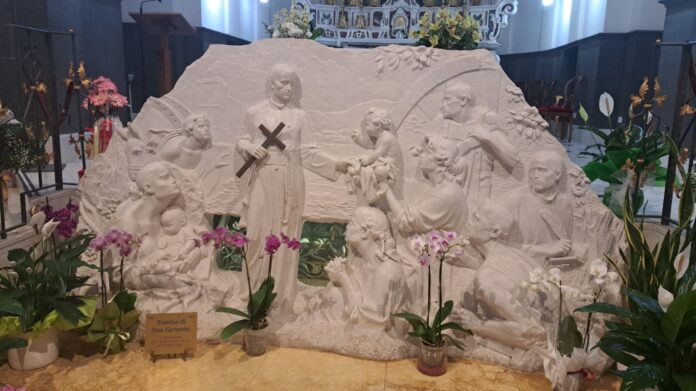Fr. Rogério Gomes CSsR, Superior General of the Congregation of the Most Holy Redeemer, participated in the celebration in honour of St Gerard Maiella at Materdomini, the shrine of St Brother Redeemer, on 16 October, where he delivered a homily.
Below, we publish the full text of Father General’s homily.
HOMILY – FEAST OF SAINT GERARD
Dear Brothers of this Community of Materdomini,
Dear Brothers and Sisters participating in this Feast of Saint Gerard and all of you who accompany us through the social networks.
Today, 16 October, we celebrate the memory of our dear Brother Gerardo Majella, who once ran away from home with one goal: to be a saint. This goal guided his entire life, and even in the face of difficulties, he did not lose heart because he always knew how to listen to the voice, do the will of ‘dear God’ and be at the service of others. “In Saint Gerard, we remember the abundant and strong presence of grace; we are struck by his intense luminosity, manifested in his total abandonment to Christ and in his joyful and jubilant availability for the benefit of his brothers and sisters; we perceive the profound truth of the prodigious facts transmitted by popular memory. And for this reason, we are left with a great desire to know him more and better”.[1]
The devotion to St Gerard Majella is well known and offers comfort and hope to many people, especially those facing pregnancy and maternity challenges and families. Because of his simplicity, he is considered an example of a life of holiness and compassion towards the weakest and is an essential figure in the Catholic tradition.
The prayer for his day reads: “O God, who from his youth drew Saint Gerard and made him conform to the image of your crucified Son, make us also, following the example of his life, be transformed into the same image.”[2] The image we know of our brother is that he stands with the cross in his arms, which reminds us of Jesus’ handing over to humanity and Gerard’s handing over to the Redeemer. Starting from the Redeemer’s kenosis, Gerard makes it his own by letting himself go. In this way, his life recalls important values for our consecration: intimacy with God, simplicity of life, detachment, the joy of serving, fraternal life and an intense apostolic life.
Gerard’s path to holiness is built on the everydayness and simplicity of his life. Around his character, many facts have been created that have made him a ‘miracle-working saint’ or, at times, a character sui generis, even out of reality. This type of literature should be understood as the fruit of an era, but it highlights Gerard’s closeness to the people. “The Lord favoured him with charisms, including prophecy, the intelligence of hearts and the gift of miracles”.[3] As such, he is a person who can be touched invoked in the most diverse situations of life. That is why he is a man who incarnates himself in the reality of the simplest people, from those who go to the convent to ask for bread to those who ask him for advice and spiritual guidance, as we read in his epistolary. This is possible because the ‘dear God’ of whom Majella speaks is the incarnate Word who emptied himself and became a travelling companion on the roads of life. He is so close that, according to one of the stories, to find the key that fell into the well, he ties up an image of the baby Jesus and brings it back… His intimacy and friendship with God allow him to do this. This demonstrates a spirituality of tenderness.
This way of being permeated his personal and consecrated life. He did nothing extraordinary except for the most challenging thing: to love. Only love makes us holy because “God is love” (1Jn 4:8). We are his image and likeness (Gen 1:27). Even if we spoke the language of angels and men, without love, we would be nothing (cf. 1 Cor 13:1). So love is the place where the divine and the human meet, manifest themselves and generate life and beauty in the broadest sense of the term. He who does not love walks in loneliness and death and does not find himself. By giving himself totally to God, Gerard also gave himself to his neighbour, especially to the poorest and most abandoned.
Gerardo consecrated his short life to God in the Congregation of the Most Holy Redeemer. He chose to be Brother Gerardo. Herein lies the beauty of Redemptorist Consecrated Life, which includes these two ways of being and realising one’s vocation in the Church: being a religious Brother or a religious priest. Both have a common core: consecration to the Lord and being a brother. Our ministry is different, and this should not be a reason for distance between us; on the contrary, since we are all consecrated and brothers, we must walk together, with the diversity and beauty of our talents, and apply them in favour of the greater good, the explicit proclamation of the Gospel to all men (cf. Const. 1-5). “Every religious consecration manifests to the faithful that the mystery of Christ the Saviour is fulfilled now and here, in this world and through the Church today. In every time and place, consecrated persons reveal to their contemporaries the features of Jesus, by which He showed that the mystery of the Kingdom of God had already broken into history”. [4] This is our mission!
St Gerard Majella’s devotion to Our Lady is vital to his life and spirituality. St Gerard was known for his deep devotion to the Virgin Mary and considered her a guide and refuge in the difficulties and challenges of life. His devotion to Our Lady reflects the importance of the figure of Mary in the Catholic tradition and the Church’s teaching on her maternal intercession. Many people turn to St Gerard and Our Lady in times of difficulty, hoping to receive comfort, guidance and protection.
May St Gerard awaken in the hearts of many young people the desire to consecrate themselves to God as brothers and help us to be truly brothers to one another and to live our missionary vocation with joy, following the Redeemer who calls us each day. So be it. Amen!
[1] MAJORANO, Sabatino. Cartas e outros escritos de São Geraldo. In: UNIÃO DOS REDENTORISTAS DO BRASIL. Espiritualidade Redentorista 6: Escritos e Espiritualidade de São Geraldo Majela. Aparecida: Santuário, 1995, p. 242.
[2] Missale Redentorista, p. 87.
[3] Missale Redentorista, p. 47.
[4] CONGREGAÇÃO PARA OS INSTITUTOS DE VIDA CONSAGRADA E AS SOCIEDADES DE VIDA APOSTÓLICA. Identidade e Missão do Religioso Irmão na Igreja. Lisboa: Paulus, 2015, p. 27.
The original text is in Italian






